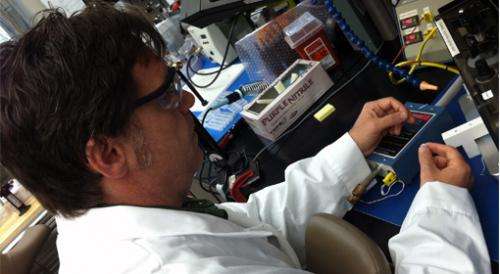Researchers use special foams to treat aneurysms

An innovative method for treating potentially fatal brain aneurysms by filling them with foam-like plastics is a step closer to clinical trials after demonstrating an ability to promote healing at unprecedented levels, says a Texas A&M University researcher who is developing the treatment.
The treatment, which makes use of special plastics called polyurethane-based shape memory polymer foams (SMPs), is the result of research by Duncan Maitland, associate professor in the university's Department of Biomedical Engineering. Its effectiveness in helping to the heal aneurysms is detailed in the May issue of the Journal of Biomaterials Research and is considered a significant milestone in the continued development of the treatment, Maitland says.
"We have demonstrated that SMP foam is a biocompatible aneurysm-filling device when implanted into a vein pouch aneurysm model, and our initial pathological results demonstrate the feasibility of these materials as aneurysm-filling devices for clinical applications," says Maitland, who is working with a team of researchers that includes Fred Clubb of Texas A&M's College of Veterinary Medicine and Biomedical Sciences and Matthew Miller of the Texas A&M Institute for Preclinical Studies. Their work is funded by the National Institute of Biomedical Imaging and Bioengineering, part of the National Institutes of Health.
The group's findings, Maitland says, could eventually provide doctors with a more effective and less risky method for treating aneurysms – blood-filled, balloon-like bulges in the walls of a blood vessels that can rupture and cause neurological damage that is debilitating or even fatal, especially if near the brain. In the United States, about 30,000 people per year suffer neurological damage or die from ruptured cerebral aneurysms.
Typically, treatment of aneurysms involves either surgically clipping the aneurysm or implanting platinum coils to reduce pressure on the vessel walls so that healing can occur before the aneurysm ruptures, Maitland says. These coils, he explains, can be effective but also can pose risks to the patient. In addition to sometimes causing inflammation that can inhibit healing, these coils can compact over time and cause subsequent rupture or re-rupture or lead to the formation of aneurysms adjacent to the original aneurysm, he says.
Maitland is working to overcome the limitations of conventional treatment methods by employing an alternate filling method for aneurysms that relies on polyurethane-based SMP foam instead of platinum coils. These foams have the ability to be made into a primary shape and then transformed into another shape with an increase in temperature, Maitland notes.
Their shape-shifting ability makes these foams an ideal material for filling aneurysms, he explains. In Maitland's system, the SMP foam remains in a temporary crimped shape so that it can be inserted into a blood vessel and delivered to the aneurysm with the use of a microcatheter. Once at the aneurysm site, the foam is triggered to expand and fill the aneurysm sac by laser light from an optical fiber, Maitland says. Similar to how a sponge works, the SMP foam enables blood to fill the aneurysm, forming a clot and promoting the growth of endothelial cells that work to heal the aneurysm, he explains.
Maitland's latest round of findings show the rapid formation of these endothelial cells over the opening of the aneurysm where they work to stop blood from entering the aneurysm. In lay terms, these important cells basically plug the aneurysm, and their presence in the right alignment and location is a chief signature of a desired healing response, he says.
Test results also reveal SMP foams are promoting a long-term health of the areas of the blood vessel affected by the aneurysm, reducing the chances of the aneurysm reforming, he notes. This is evidenced, Maitland explains, by the formation of the types of cells and tissue that lead to a more stabilized healing. For example, the aneurysms treated with SMP foams show an increased presence of collagen instead of fibrin. Collagen, he notes, is a far more mechanically stable tissue than fibrin, which is a short-term "patch" and abundant in aneurysms treated with coils. That's a promising finding, Maitland says, because the more stabilized an aneurysm is, the less likely it will be to require re-treatment – something that unfortunately occurs in about 40 percent of aneurysms treated with coils.
In addition to demonstrating the promotion of an aggressive healing response in aneurysms, the SMP foams developed by Maitland and his team are showing strong signs of biocompatibility – their ability to be accepted by the body. In fact, the foams are outperforming other FDA-approved materials used in blood vessels, he notes. That's important, Maitland says, because it means less inflammation in the area, which can inhibit the healing process. Typically, foreign objects implanted in the body trigger an inflammatory response as the body attempts to reject them, but the SMP foams used by Maitland show minimal inflammation once they are inserted into the aneurysm. Histology studies comparing SMP foams to two types of commonly used FDA-approved sutures used in vascular surgeries show the foams to outperform both types of sutures, meaning fewer cells associated with inflammation are showing up near the foams, Maitland notes.
"Not only do we see a lower inflammatory response, the foams are promoting a more aggressive healing response within the aneurysm," Maitland says. "We are seeing partial healing around 30 days and near-complete healing at the 90-day mark. This is an unprecedented level of healing with regard to this lack of an inflammatory response and the promotion of collagen and cellular growth that lead to long-term healing of the aneurysm."
















